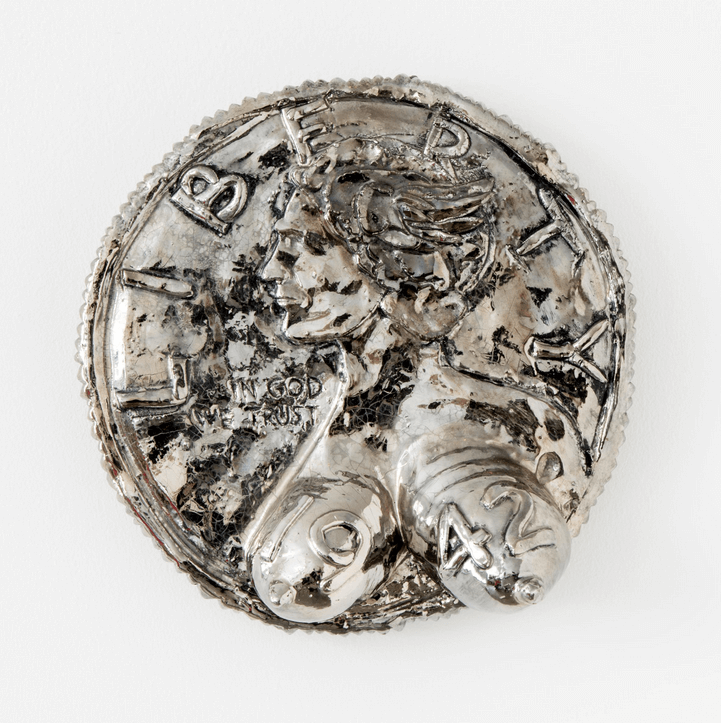Matthew Marks Gallery’s New York edition of What Nerve! Alternative Figures in American Art, 1960 to Present was shown simultaneously at its three 22nd Street Gallery locations during the summer (New York July 8 –August 14, 2015). Curated by Dan Nadel, the show focuses on four groups of artists— Hairy Who, Destroy All Monsters, Forcefield, and Funk Art— that worked largely outside of New York and Los Angeles, often operating at the intersection of art, comics, and counterculture.
Above: Robert Arneson, Miss Liberty Coin (1942 Dame), 1965, glazed ceramic 10 1/2 x 10 1/2 x 3 3/4 inches; 27 x 27 x 10 cm.

Robert Arneson, Untitled (Binoculars), 1965, ceramic with glaze, 6 x 6 x 2 inches; 15 x 15 x 5 cm.

Installation view at Matthew Marks, New York of “What Nerve! Alternative Figures in American Art, 1960 to Present.” Click to see a larger image.
The show makes an argument for a new cannon of American art and culture since the 1960s. While we may take exception to Peter Voulkos being lumped under Funk Art (or Ken Price for that matter, Robert Arneson fits) it was another sign that the fine arts takeover of the art end of ceramics is working well and that history is being taken care of, weaving it into the fabric of the American avant-garde.

Peter Voulkos, Blue and Gray, 1959, stoneware, slips, glaze, 52 x 21 x 16 inches; 132 x 53 x 41 cm

Installation view of “What Nerve! Alternative Figures in American Art, 1960 to Present.” Click to see a larger image.
Focusing on four groups of artists practicing away from the cultural capitals of New York and Los Angeles, What Nerve! presents an alternative history of American art since the 1960s. As the exhibition’s curator, Dan Nadel, has written, “When confronted with a system that seems impenetrable, outsiders tend to band together.” The Chicago-based Hairy Who exhibited together from 1966 to 1969.
Its members were Jim Falconer, Art Green, Gladys Nilsson, Jim Nutt, Suellen Rocca, and Karl Wirsum. Funk Art took root in the San Francisco Bay Area in the 1960s and 1970s and is represented in the exhibition with works by Jeremy Anderson, Robert Arneson, Joan Brown, Roy De Forest, Robert Hudson, Ken Price, Peter Saul, and Peter Voulkos. In Ann Arbor, Mike Kelley, Cary Loren, Niagara, and Jim Shaw formed Destroy All Monsters as students in the 1970s. Forcefield members Mat Brinkman, Jim Drain, Leif Goldberg, and Ara Peterson, active in Providence from 1996 to 2003, created fictional personas complete with pseudonyms and elaborate garments.

Ken Price, Red Egg, 1968, fired and painted clay, 13 1/2 x 16 x 14 1/4 inches; 34 x 41 x 36 cm
This exhibition reassesses the artists associated with these four groups, providing a new understanding of their influence on contemporary art history. Distinct as their artworks are in style, period, and place, the artists all share a common set of concerns. Inspired by a wide array of influences including folk art, advertising, primitive art, comic books, and fetishism, they all favor figurative imagery that diverges from the predominant artistic style of the time.
The groups presented here emerged from close collaboration and, in the case of Destroy All Monsters and Forcefield, experimental living arrangements. All of them embrace alternate aesthetics and unconventional media. Lawn chairs, purses, comic books, chain metal shrouds, and a video installation join rarely seen paintings and drawings. The Collected Hairy Who Publications 1966 – 1969, the first book to gather the artist’s books of the Chicago-based Hairy Who into a single volume, will be published on the occasion of the exhibition. Accompanying it are a scholarly essay and an extensive archive of Hairy Who posters, exhibition photographs, and ephemera.

Installation view of “What Nerve! Alternative Figures in American Art, 1960 to Present.” Click to see a larger image.
A version of the exhibition was presented last fall at the RISD Museum in Providence, RI, which was accompanied by a fully illustrated catalogue with texts by Dan Nadel, Robert Cozzolino,Brian Chippendale, Dominic Molon, Roger Brown, John Smith, Naomi Fry, Michael Rooks, Nicole Rudick, and Judith Tannenbaum.
Love contemporary ceramic art + design? Let us know in the comments.

Add your valued opinion to this post.